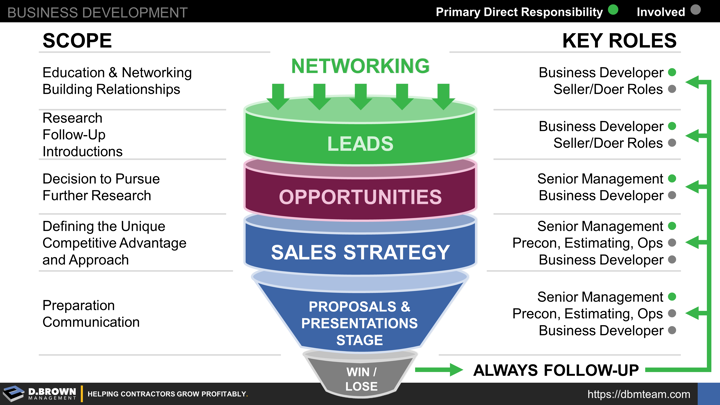Once strategic market choices are made and the basic stages for winning work have been defined in a funnel, it is important to define the key work to be done and roles involved at each stage. This varies heavily based on the contractor's stage of growth and market(s) they are working in. Below are examples by stage that can be used as a starting point.
- Networking: All other things being equal, more networking activity will translate into more leads and opportunities. Networking is the core of business development and covers a full range of activities including education. The objective is creating new relationships and building existing ones. If a contractor has a dedicated "Business Developer," then this is the role that has primary responsibility for this stage. Learn more about integrating the different business development models.
- Leads: This includes additional research about companies, people, programs, and projects that came up during the networking activities. Where applicable, it includes introductions to other team members and key executives in the company and to others in your network who may benefit from knowing each other. This is also the primary responsibility of a dedicated business developer or fall to senior management roles like a Project Executive, Vice President, or above.
- Opportunities: Second only to making good strategic market choices, the decisions about which opportunities to pursue, and which ones not to pursue are the most highly leveraged decisions made by senior management. Be clear and transparent about your evaluation criteria to provide good feedback to the rest of the team. Remember that good business development activities should generate about 80% of opportunities that are in alignment with strategic market choices. There should be enough quantity to comfortably achieve your revenue and margin targets. Decision rights for opportunity go/no-go should be clear based on factors like size, scope, complexity, location, and customer with the highest levels of decisions reserved for owners (or board) regardless of how large the contractor grows to. The business developer along with preconstruction, estimating, and operations are all involved at this stage. For some projects, other key roles may need to be involved including fleet manager, workforce development, and finance.
- Sales Strategy: What is the unique competitive advantage the company brings to this opportunity based on what you know about this market, project, customer, and competition? Factors include capabilities and capacity at this stage, during preconstruction, and construction looking internally and at key trade partners. What is the optimal approach in terms of how, who, and when?
- Proposals and Presentations: This is where the sales strategy becomes reality. It may be as simple as submitting a fixed-price bid on the required forms at the required time. It may be as complex as a proposal 40+ pages in length, an interview, and dozens of "back channel" communications with key decision makers, influencers, and other stakeholders.
- Win / Lose: Regardless of the outcome, it is an opportunity to learn. Always follow up and look for ways to improve each stage.
Self-Evaluation and Team Discussion
- What do the roles and responsibilities at each stage of your funnel look like?
- Are they clearly defined in your job descriptions?
- Are they being performed as defined?
- Are the outcomes of each stage occurring as expected?
Please schedule time to talk about your answers to the questions above. All relationships begin with a simple conversation. We will freely share anything we have learned that could help.

